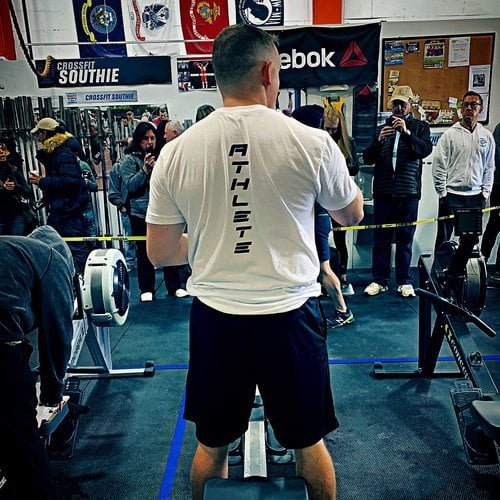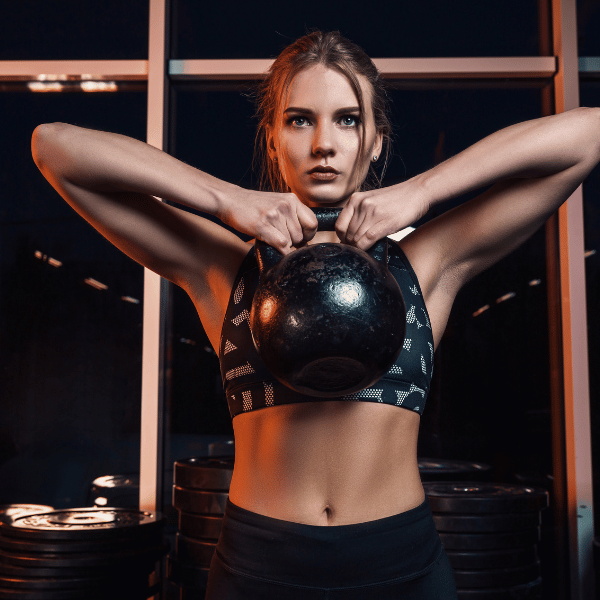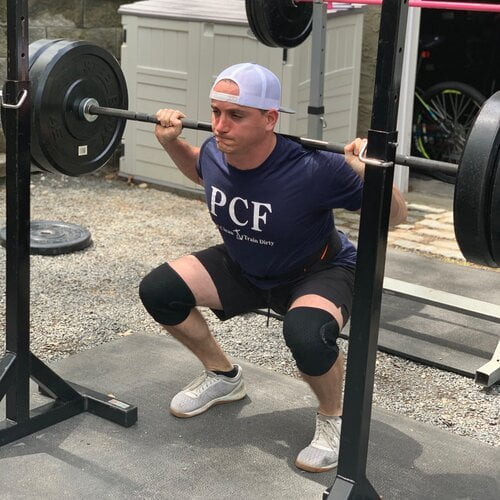3 Factors To Guide What You Eat Before A CrossFit Competition
Last weekend, I competed in the CrossFit Southie Showdown in Boston, Massachusetts, with the other coaches and athletes of Port CrossFit. So, this would be an excellent opportunity to go over the nutrition protocols I use to help WillPower Strength & Nutrition clients in typical training sessions and on competition day compete in CrossFit, perform their best, and express the fitness they gain throughout the year. These are the same protocols I teach clients in my 1:1 Pain-Free Performance Program.
What to eat before a CrossFit competition?
Fueling your body adequately on a CrossFit competition day is more than just a good idea; it’s a performance essential. Unlike everyday nutrition, which may prioritize health and body composition, game day nutrition is solely focused on providing the energy required to excel in the intense sport of CrossFit. As you gear up for your first competition, understand that eating before stepping onto the competition floor can significantly impact your performance.
The right pre-competition fuel ensures you have the stamina, strength, and mental clarity to push through the challenging workouts that await. Proper nutrition on competition day is a nuanced process, influenced by various factors that we’ll delve into below. So, let’s explore what to eat before a CrossFit competition to optimize your chances of victory.
Protein
In competitive CrossFit, when you’re pushing your limits through intense events packed into 1-2 days, handling protein intake can make all the difference. To recover efficiently without risking stomach discomfort in the next event, you might find protein supplements like protein powder and protein bars handy. Aim for a moderate protein intake, about 15-30 grams per serving, to support your muscles without overwhelming your digestive system.
Go for sources that digest quickly; whey protein, found in many protein powders and shakes, is excellent for swift assimilation. Likewise, opt for protein bars with a balanced protein profile for convenient on-the-go refueling. When consumed within 10-15 minutes of finishing the event, the protein can have time to digest well and aid in recovery throughout the day.
Carbohydrates
Strategic carbohydrate consumption is critical to performing our best. Start by ensuring a carbohydrate-rich meal 3-4 hours before the competition to stock up on glycogen. For a quick energy boost just before an event, consider easily digestible sources 30-60 minutes prior. Aim for 30-60 grams of carbohydrates per hour during the competition, again utilizing sports drinks or energy gels to maintain energy levels during breaks.
Post-event, kickstart glycogen replenishment by consuming simple and complex carbohydrates within the first 30 minutes. Sports drinks and fruit juice can be excellent options for rapid carbohydrate absorption, aiding recovery and ensuring you’re fueled for subsequent high-intensity endeavors. If you are competing over multiple days, once the day of competing is over, have a dinner with plenty of carbohydrates such as white rice or sweet potatoes. Ultimately, individual preferences play a role, so feel free to experiment during training to find the perfect fueling strategy that works for you.
Fat
Since CrossFit competitions are high-intensity events that unfold over 1-2 days with short breaks, fat intake during competitions requires a strategic approach. You should focus on easily digestible, low-fat options to avoid gastric discomfort. Including a small amount of fat (around 5-10 grams) in pre-competition meals is reasonable, as this won’t hinder digestion during the upcoming events. However, keep fat intake minimal in the hours leading up to and during the competition to prevent potential gastrointestinal issues.
Opt for low-fat protein sources and easily digestible carbohydrates for sustained energy without burdening your digestive system. Post-event, when the competition allows for a more extended recovery period, you can incorporate moderate amounts of healthy fats into your meal to support overall nutrition. Remember, individual responses can vary, so consider experimenting with your fat intake during training to find what suits your body best on competition days.
Water
Drinking plenty of water is crucial in optimizing health, aesthetics, and performance, yet it’s often overlooked. Leading up to your CrossFit competition, aim to consume your typical amount of water daily. Rather than chugging your water in one shot, you’ll want a steady intake of water throughout the day.
If you consume caffeine, intersperse your coffee with water intake. On the day of the competition, maintain your water intake by bringing water with you. Aim for 50% of your body weight in oz that day, distributed throughout the event.
Electrolytes
Before delving into what to eat on the day of a CrossFit competition, it’s essential to address electrolyte replenishment—leading up to the competition, as you hydrate, target ~2500 mg of sodium daily. You’ll also want to consume supplements or foods rich in magnesium and potassium for muscle contractions. Electrolytes, minerals crucial for optimal bodily function, play a role in maintaining pH levels, regulating blood pressure, and facilitating muscle contraction/relaxation. Addressing electrolyte imbalances is especially important for overall performance.
Things to consider when fueling for a CrossFit competition
The Demands of A CrossFit Workout
The first step in prescribing a nutrition protocol for CrossFit Athletes is determining the sport’s energy systems and bioenergetic needs. For a sport like CrossFit – most, if not all, of the energy needed to perform the workouts is going to be satisfied from carbohydrates either consumed or inside your muscle tissue as Glycogen stores. This is because carbohydrates are the body’s preferred fuel source during a high-intensity workout that lasts longer than 10-30 seconds.
Carbohydrates will be stored as glycogen in the muscle and liver and in small amounts in the bloodstream. During a training session or competition setting, like in an Open workout, glycogen stores will be called upon and used to create Adenosine triphosphate (ATP), used in muscular contraction. The body can store up to 400 grams of glycogen in the muscle and about 100 grams in the liver.
We want these levels topped off as much as possible during competition to ensure athletes have the glycogen stores they need for high-intensity work, such as in a local competition or CrossFit Open. This kind of high-speed, compound movement that recruits large amounts of muscle mass will start to chip away at these glycogen stores very quickly with each workout. With that, a typical local competition will generally have at least three workouts per day. Thus, we know that carbohydrates will be a great way to maintain energy levels on a day of competition.
The best foods for high Carbohydrate intake include Sweet Potatoes, Rice Cakes, and Fruit, and if you are short on time between workouts, a sugary sweetened sports drink can provide plenty of carbs for intense exercise. Generally, you will want to limit complex carbs or avoid a full meal as your pre-workout meal unless there is enough time to digest it. Which is a 60-180 minute window, depending on the types of food.
Lean protein will be essential in repairing muscle damage from workout to workout and then daily from a tissue recovery standpoint to provide the amino acids necessary after a high-intensity workout. The best way to do so is to have a protein shake with high-quality protein, such as Whey protein, with fast-digesting carbohydrates and as little fat as possible. Protein will likely not be called upon to provide energy to the body if carbohydrates are present, and from a practical standpoint, we wouldn’t want it to.
Protein takes longer to be used for energy as it must be converted into glycogen and is typically only broken down for energy in starvation states. If protein is used to fuel competitive activities during high-intensity workouts, something is wrong. The final macronutrient, fat, will play a role in the day. Still, it will function primarily as a tool at the right time to keep athletes satiated between workouts and then as a way to “recover” calories at night to make sure athletes are not in a calorie deficit.
Although it is the most calorie-dense macronutrient and provides the most energy per gram, it will not be used to provide energy for athletes in a typical CrossFit workout because of the high intensity of the workouts. Healthy fats are an excellent energy source but require too much time to be converted into ATP and are only used when oxygen is available to Mitochondria in lower intensity, longer duration workouts.
Meal Timing Pre and Post the workout
The next factor to consider when fueling athletes for a CrossFit competition is the timing of the meals they consume. Timing is critical for optimal performance because we want the macronutrients we consume in food to be available to athletes when needed. For instance, if an athlete has a workout at noon and it takes roughly 1-3 hours for a complete meal to be digested, eating their first meal at 7 am or 1:30 pm is not ideal because they will have to operate on a full stomach.
When athletes eat a meal, a cascade of hormonal activities begins to store macronutrients where they need them. As mentioned above, insulin spikes and storage begins to take place, such as storing glycogen in the muscle tissue. However, once the food has been digested, the body begins to use what was provided for every bodily function, not just heavy deadlifts and burpees. Functions like brain activity, tissue maintenance/repair, nerve function, etc., pull substrates from storage sites.
If this begins to happen before an athlete’s workout time, they will not be optimally fueled to perform. Their blood sugar may drop to fasting levels, and glycogen levels may begin to be depleted from other body functions. Thus, eating too far away from their event for the first time must also be avoided in your pre-workout nutrition. Timing foods appropriately with digestion time is also critical.
The bioavailability of micronutrients can play a role in athlete fueling. Once food enters the stomach, the digestion process will happen immediately, but it also takes time to complete. Athletes need to allow adequate time for the food to go through the digestive tract and into the small intestine, where it can be absorbed and shuttled. An athlete needs to eat their pre-workout meal closer to the workout so the food they have eaten will be stored in time to help produce energy.
Individual Food Tolerance During High-Intensity Exercise
Although this is last, it is by far the most important and will, in most cases, trump both demands of the sport and meal timing. Anyone who has ever engaged in high-intensity, strenuous activity can relate when I say that hunger does not always immediately follow. Often, sensations of hunger don’t emerge until an hour to two hours post-exercise. This is why post-workout shakes are so popular – they are easy to get down nutrients when we need them most.
Athletes are not typically immediately hungry after they train because the sympathetic nervous system is ramped up, so the hormones responsible for hunger, such as ghrelin, and the parasympathetic nervous system, which is responsible for digestion, are suppressed. Whether you are exercising or running from a bear, you don’t need to be eating or digesting food, and your body knows it, so the Central Nervous System makes adjustments that include the suppression of hunger, which takes time to reverse.
If the day or weekend goal is to optimize performance, the athlete’s feelings and preferences must be considered. If an athlete finishes a challenging workout, slams a post-workout shake, and has some juice but can’t stand to have a meal before their next event, it is what it is. Forcing them to eat a meal will only negatively affect performance if they don’t like feeling full before a workout or will become nauseous if they force food down too soon.
As a nutrition coach, the way around this is to supply nutrient-dense carb and protein sources that are easily consumed and digestible. I mentioned protein shakes earlier – a shake consisting of protein powder in water and juice is an excellent option during competition because the whey protein and glucose in juice are fast-digesting and because it is in a liquid medium, it will go down very easily. The key here is to provide enough protein and carbs in the shake to supply the athlete with the fuel they need to recover and perform in the next workout without overdoing it.
Typically, anywhere from 15-30g of protein and 30-75g of carbs will suffice, depending on the event they just did. A simple strength event will require fewer carbs to recover than a fifteen-minute AMRAP of deadlifts and squats will. Another option is fast-digesting carbs like gels or gummies that are easy to consume and supply quick energy. If you’re an athlete reading this, I hope you can apply this information to your next competition! These are the same things I consider when prescribing nutrition protocols for my athletes.
What to eat in the days leading up to a CrossFit competition
As the excitement builds for your first CrossFit competition, it’s understandable that nerves might lead you to reconsider your nutrition strategy. However, it’s crucial to remember that the days leading up to the competition differ from when experimenting with new foods. Many athletes, especially those new to the competitive scene, tend to change their diet out of nervousness.
The most important thing to keep in mind is consistency. Stick to the whole foods your body is accustomed to, ensuring you maintain stable digestion and energy levels. I learned this lesson the hard way on my first competition when I decided to stick to my weight loss plan, only to lack energy during the intense CrossFit workouts.
Remember, the sport of CrossFit demands high-energy fuel, primarily derived from carbohydrates. So, keep your food intake consistent, stay hydrated, and resist the temptation to cut or dehydrate, ensuring your glycogen stores are topped off for peak performance come competition day.
Wrapping up!
Game-day nutrition can be as complicated or as simple as you want to make it. What it boils down to is what the needs of the sport are. How long will food take to digest? But, most importantly, what are the athlete’s preferences about food tolerance and exercise? As with anything nutrition-related, there are no cookie-cutter programs. Nutrition for CrossFit is not a one-size-fits-all approach.
It’s an individualized journey influenced by workout demands, meal timing, and personal food preferences. For tailored guidance on optimizing your nutrition and achieving peak performance, consider booking a free consultation with WillPower Strength & Nutrition HERE.
Your success in CrossFit starts with a personalized approach to nutrition, and I would be happy to chat about how I can help you get there!







